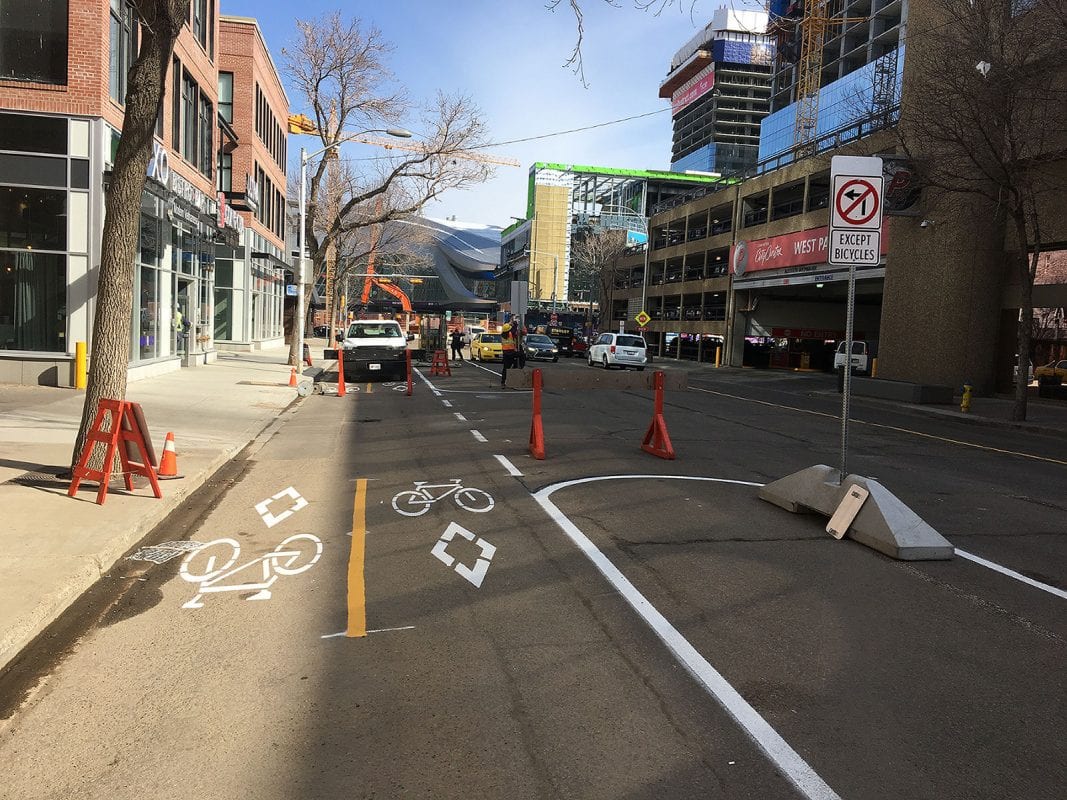For many Edmonton cyclists, this has been a long time coming. For years, it seems Edmonton has been playing catch-up with other major cities when it comes to creating a bike network that allows its 2 wheeled citizens safe, easy transportation through the city streets. But that’s all starting to change.
Previous attempts at bike lane implementation were nothing more than painted lines on existing roadways and signs letting drivers know about the shared lanes in those areas. It was a start that was not well received and many drivers felt it caused added congestion and confusion in already busy areas of the city. This past year, the city removed many of those painted bike lanes due to congestion and non-use issues in preparation for a new system of protected lanes that have been recently unveiled.
“Our new direction was to construct high quality, all season bike routes for all ages in population dense areas,” says Olga Messinis who is the downtown bike network project manager for the City of Edmonton.
Focusing on areas of the city where there is already a high bike ridership including Old Strathcona, Oliver and Downtown, the project would build protected bike lanes separated from the vehicle lanes by concrete curbs, bollards and planters. The separation is an additional level of protection in higher traffic areas to provide a safe, all ages and abilities bike route.
The bike network is adaptable, meaning the bike lanes do not require extensive construction or major roadway changes to be implemented rapidly. Materials used in the project are relatively available and cost effective to achieve the desired separation. The only permanence in infrastructure is the traffic signal upgrades throughout the downtown core.
“Once Council approved the implementation of the bike network in October 2016, we hit the ground running as we really only had about nine months to plan, design and implement the project,” says Messinis.
In that time, a team of partners had to develop a monitoring and evaluation program. They also wanted to encourage public engagement and communication as well as develop an education program. Preliminary design work was planned with Stantec before actually beginning production and finally opening the bike lanes in phases.
Since it’s launch, there have been some complaints and growing pains regarding the safety and transportation in the areas with the protected lanes. Some feel that there is already too much congestion in these areas and that the lanes just provide another obstacle that slows their travel time and make turning difficult or confusing for some of the larger delivery vehicles.
“This is a very new type of bike facility in Edmonton and there is always a period of information uptake until all users get used to the new facility and the order at intersections,” says Messinis.
Members of the group studied best practices across North America and worked with Calgary on lessons they learned one year into their operations. Although European cities are well known for their bike networks, they didn’t look at specific European cities but rather referenced CROW for unique perspective on bicycle friendly streets. CROW is the technology platform for transport, infrastructure and public space from the Netherlands.
“We’ve seen seniors, young families, commuters in suits/office wear, couples riding to date nights and parents commuting into work with their really small children in tow,” says Messinis.
It’s a testament to how comfortable people feel in the new protected bike lanes.
Safety Tips Regarding Bike Lanes
- All modes of travel need to be more aware of each other. Particularly at locations where pedestrians/bikes/motorists can interact frequently (crosswalks, alley crossings, driveways).
- Most left turns across bike lanes have been designated and protected to avoid left turn conflicts between motorists and cyclists.
- Motorists are cautioned to pay attention to traffic control sign changes at intersection points and to always shoulder check.
- Most right turns crossing the bike network are not permitted on red lights. This has added safety benefits for both cyclists and pedestrians as it eliminates right turn collisions at intersections.
- Motorists and cyclists should be aware of each other and motorists are encouraged to not encroach into bike lanes.









